لا أحد يرغب في التأخر عن اجتماع ما، أو تسليم مهمة ما بعد موعدها النهائي الأصلي. هذه الأمور تبدو سيئة، ولها تأثير سلبي على الأشخاص من حولنا. وغالباً ما تكون هذه الانتكاسات غير مقصودة - فهي مجرد نتيجة سوء إدارة الوقت.
على الرغم من أنك لا تستطيع أن تتحول من شخص غير موثوق به إلى شخص فائق الاعتماد على الوقت بين عشية وضحاها، إلا أن تغيير أساليب إدارة الوقت يقطع شوطًا طويلًا نحو أن تكون أكثر سعادة وإنتاجية وإنجازًا في العمل.
ما تحتاجه حقًا هو تقنيات إدارة الوقت الصحيحة. لقد حان الوقت لتقول وداعًا للشعور بالإرهاق ومرحبًا بالشعور بالتنظيم والتركيز والقدرة. ✨
دعنا نتعمق في الأمر.
لماذا تعتبر تقنيات إدارة الوقت مهمة؟
نحتاج جميعًا إلى طرق تساعدنا على إدارة الوقت بفعالية. سواء كان ذلك في المنزل أو في العمل، فإن مهارات إدارة الوقت ضرورية إذا كنت ترغب في إنجاز قائمة مهامك.
إدارة الوقت في مكان العمل مهمة بشكل خاص. عندما تواجه مهام متعددة، وأشخاصاً يعتمدون عليك، ومواعيد نهائية حرجة للوقت، فأنت بحاجة إلى طريقة للحفاظ على تركيزك وإنتاجيتك.
ويصبح هذا الأمر أكثر أهمية عندما تعمل ضمن فريق.
فوائد تقنيات إدارة الوقت الفعّالة للفرق
إن القدرة على إنجاز قائمة مهامك في الوقت المحدد لا تؤثر عليك فقط. إنه مكسب كبير لبقية أعضاء فريقك أيضًا. والعكس صحيح أيضًا - فالتأخر في إنجاز المهام في الوقت المحدد يمكن أن يكون له تأثير الدومينو على بقية الفريق أو المشروع.
سواء كان الأمر يتعلق بتحسين التوازن بين العمل والحياة، أو تحديد أولويات المهام، أو استخدام بعض الأساليب البسيطة لتحديد الوقت، فإن الآثار الإيجابية للإدارة السليمة للوقت مفيدة للغاية.
تتمتع الفرق التي تتبع استراتيجيات لإدارة وقتها بفوائد مثل:
- تقديم عمل أعلى جودة، وأكثر تركيزًا على المهام العاجلة
- الشعور بالثقة والموثوقية في جدولك اليومي
- توازن أفضل بين العمل والحياة الشخصية
- مماطلة أقل مع حظر الوقت بشكل فعال
- علاقات عمل أقوى في جميع مهامك
- مستويات إنتاجية أعلى لتحديد أولويات المهام
- احتمالية أقل لاستنفاد مستويات طاقتك في العمل العميق
عندما يتمكن فريقك من تحديد أولويات جميع المهام، وإنجاز جميع المهام، والعمل بشكل منتج، يصبحون رصيدًا رئيسيًا لمؤسستك. إذا وجدت أنك أو أعضاء فريقك تكافح أنت أو أعضاء فريقك للحفاظ على الإنتاجية أو تتخلف عن الركب، ففكر في تجربة أدوات إدارة الوقت .
يمكن للبرامج المناسبة المقترنة ببعض تقنيات إدارة الوقت الفعالة أن تحدث فرقاً كبيراً.
15 من أكثر تقنيات إدارة الوقت كفاءة ## 15 من أكثر تقنيات إدارة الوقت كفاءة
لا يوجد نقص في تقنيات إدارة الوقت. فبالنسبة لبعض الأشخاص، فإن التحقق من المهام في مجموعات من الوقت أمرٌ ناجح - وبالنسبة للبعض الآخر، فإن الأمر كله يتعلق بمعالجة المهمة الأكثر صعوبة أولاً.
لمساعدتك في العثور على النصائح والأدوات المناسبة لك، إليك بعضاً من أكثر استراتيجيات إدارة الوقت فعالية.
1. ضع أهدافًا ذكية
من دون وضع هدف حقيقي في الاعتبار، من السهل أن تتشتت انتباهك وتماطل، ثم تضطر إلى الإسراع لإنهاء مهمتك بحلول الموعد النهائي. يساعدك تحديد أهداف SMART على فهم ما يجب التركيز عليه، حتى تتمكن من العمل على المهام بطريقة منطقية. 🎯
ضع أهدافًا مع وضع استراتيجية SMART في الاعتبار:
- محددة: معرفة الهدف أو النتيجة التي تريد تحقيقها
- قابلة للقياس: أن تكون قادرًا على تتبع التقدم المحرز في تحقيق الهدف
- قابلة للتحقيق: قابلة للتحقيق بالموارد التي لديك (أو يمكنك الوصول إليها)
- ذو صلة بالموضوع: يساعدك على تحقيق هدف أو أولوية شاملة
- محددة زمنياً : أن يكون لديك موعد نهائي واقعي يمكنك تحقيقه
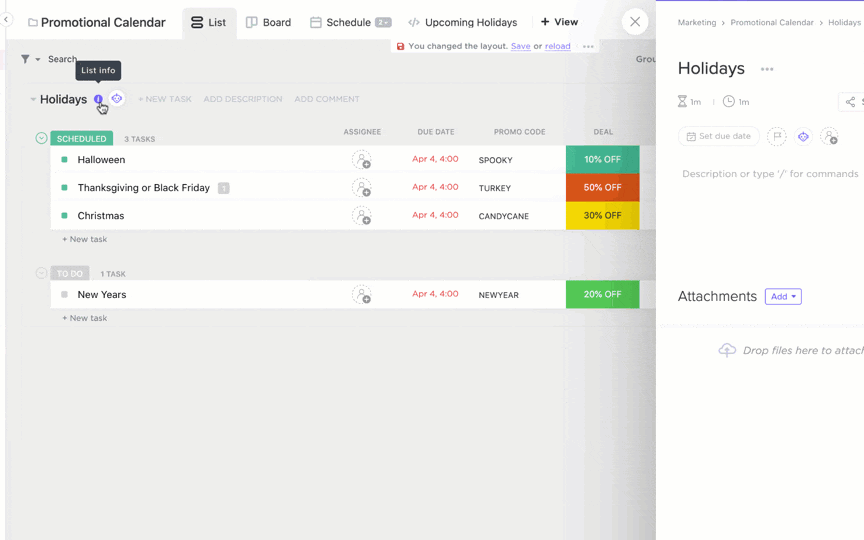
تحديد تاريخ استحقاق في عرض القائمة في ClickUp
من السهل إنشاء أهداف داخل ClickUp. أهداف ClickUp مساعدتك في تحديد أهداف SMART حيث يمكنك تصور التقدم المحرز. يمكنك أيضًا استخدام ClickUp من أجل إضافة تواريخ استحقاق إلى المهام حتى تتمكن من رؤية ما يحدث مع مهامك وأهدافك في لمحة سريعة.
2. جرّب حظر الوقت للعمل على أهم مهامك
معظمنا لديه فكرة تقريبية عن المدة التي قد تستغرقها مهمة ما. استخدم ذلك لصالحك، واستخدم حظر الوقت لمساعدتك في الحفاظ على إنتاجيتك وتنظيمك.
يعمل حظر الوقت من خلال تخصيص فترات زمنية لمهام محددة. خلال هذا الوقت المحدد، تعمل على هذه المهمة فقط وتتجنب تشتيت الانتباه عن المجالات الأخرى. هذه طريقة رائعة للحفاظ على تركيزك وتجنب المماطلة والوصول إلى أفضل عقلية للعمل العميق. 👀
يجد الكثير من الناس أن حجب الوقت مفيد عندما يحتاجون بالفعل إلى فترات من العمل العميق. يمكنك جدولة وقت في تقويمك للتركيز على مهمة صعبة، ثم ملء المناطق الأخرى حولها بمهام أقل صعوبة.
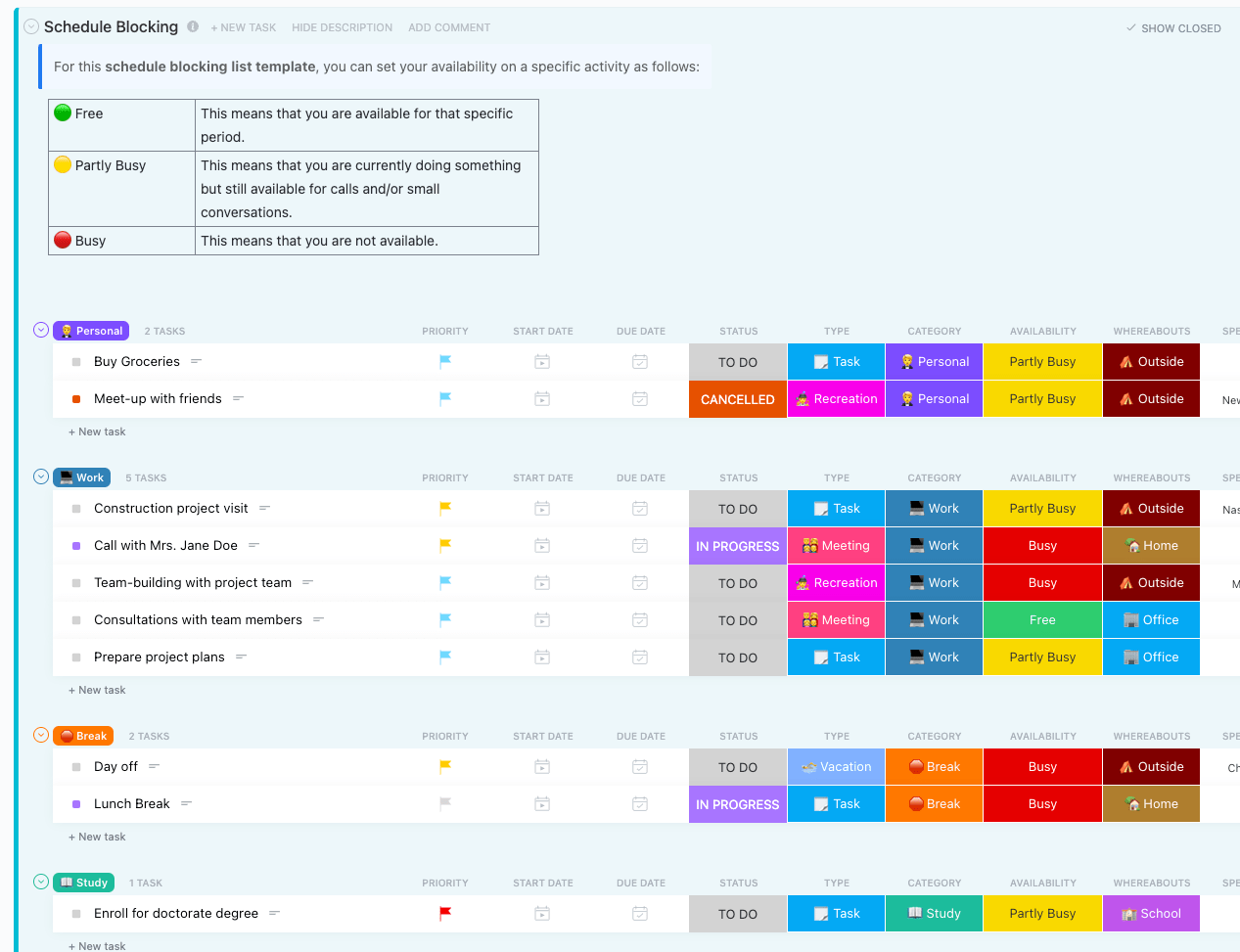
تتبّع الاجتماعات أو الأحداث الحالية والماضية والمستقبلية باستخدام قالب ClickUp لحظر الجدول الزمني
يساعدك التركيز على العمل العميق أيضًا على العمل مع مستويات طاقتك - خصص وقتًا محددًا عندما تكون في قمة نشاطك، واترك المهام الإدارية أو المهام الأصغر إلى الوقت الذي تشعر فيه بالتعب أو تحتاج إلى استراحة.
لدينا هنا في ClickUp، لدينا الكثير من النماذج المفيدة قوالب حظر الوقت . ستجد قوالب لمساعدتك تخطيط أيامك وأسابيعك وشهورك ، مع كل من طرق عرض التقويم والقائمة التي تكمل الطريقة التي ترغب في رؤية جدولك الزمني بشكل أفضل.
3. كل ذلك الضفدع
كُلْ ذلك الضفدع هي استراتيجية لإدارة الوقت تدور حول تحديد الأولويات. باستخدام هذا الأسلوب، ركز على المهام الأكثر أهمية أو الأكثر تطلبًا أولًا - ولا تنتقل إلى أي شيء آخر حتى تكتمل.
إذا كنت من المماطلين، فقد تكون هذه هي الاستراتيجية المناسبة لك. فمن خلال إجبار نفسك على التعامل مع المهمة الأكثر أهمية أولاً، لن تتمكن من تجنبها.
وبدلاً من ذلك، فإنك تستهلك طاقتك الأكثر قيمة لإكمالها أولاً، ثم تشعر بالرضا لأنك قد أنجزت بالفعل أصعب الأعمال ويمكنك الاسترخاء ذهنيًا لبقية اليوم من خلال القيام بمهام أسهل. 🏖️
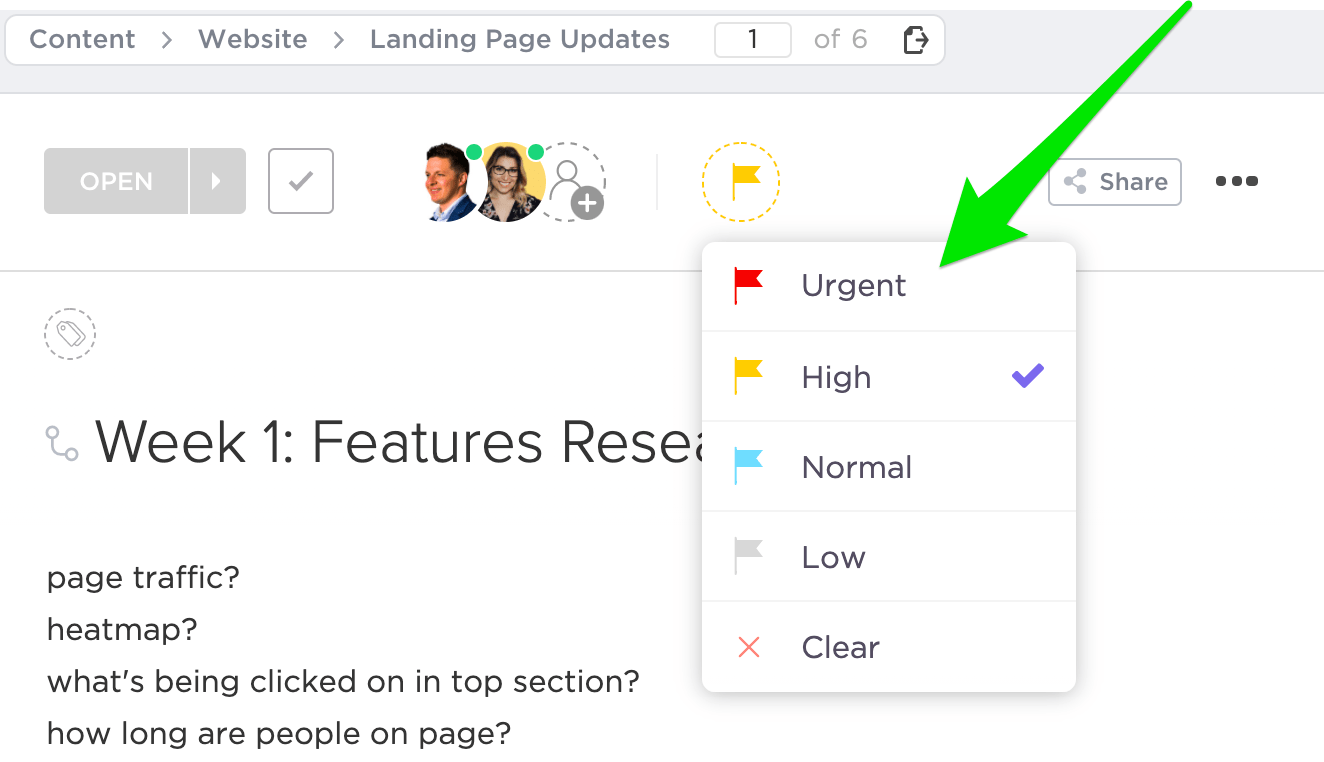
حدد الأولويات في ClickUp للتمييز بشكل أفضل بين ما يجب القيام به الآن وما يمكن تأجيله
اختصر طريقك إلى النجاح باستخدام هذه الطريقة باستخدام ميزة الأولويات في ClickUp . اعمل من خلال قائمة المهام الخاصة بك ومنحها علامة أولوية. عيّن مهمة واحدة في جدولك اليومي على أنها عاجلة، واجعلها "ضفدعك" ليوم العمل.
4. جرب مصفوفة أيزنهاور
إن مصفوفة أيزنهاور قدمها الرئيس دوايت أيزنهاور كطريقة لتصنيف المهام لفهم أهميتها. ولا تزال هذه المصفوفة حتى اليوم أسلوبًا شائعًا لإدارة الوقت، حيث تساعدك على تصور ما هو أكثر أهمية.
يتضمن هذا النهج لإدارة الوقت تقسيم مهامك إلى هذه الأرباع:
- عاجلة ومهمة
- غير عاجلة ولكنها مهمة
- عاجلة ولكنها غير مهمة
- غير عاجل وغير مهم
يساعدك النظر في ما إذا كانت مهمتك عاجلة و/أو مهمة على إدراك ما إذا كان ينبغي عليك تحديد أولويتها أم لا. يجب إنجاز المهام العاجلة أولاً - خاصة إذا كانت مهمة أيضاً.
اعمل على ترتيب المهام حسب أهميتها، واعلم أنه من غير المرجح أن تنجزها كلها. يمكن أن يساعدك هذا التمرين أيضًا في تحديد الأماكن التي تحتاج إلى تفويضها أو طلب المزيد من الموارد. 🙌
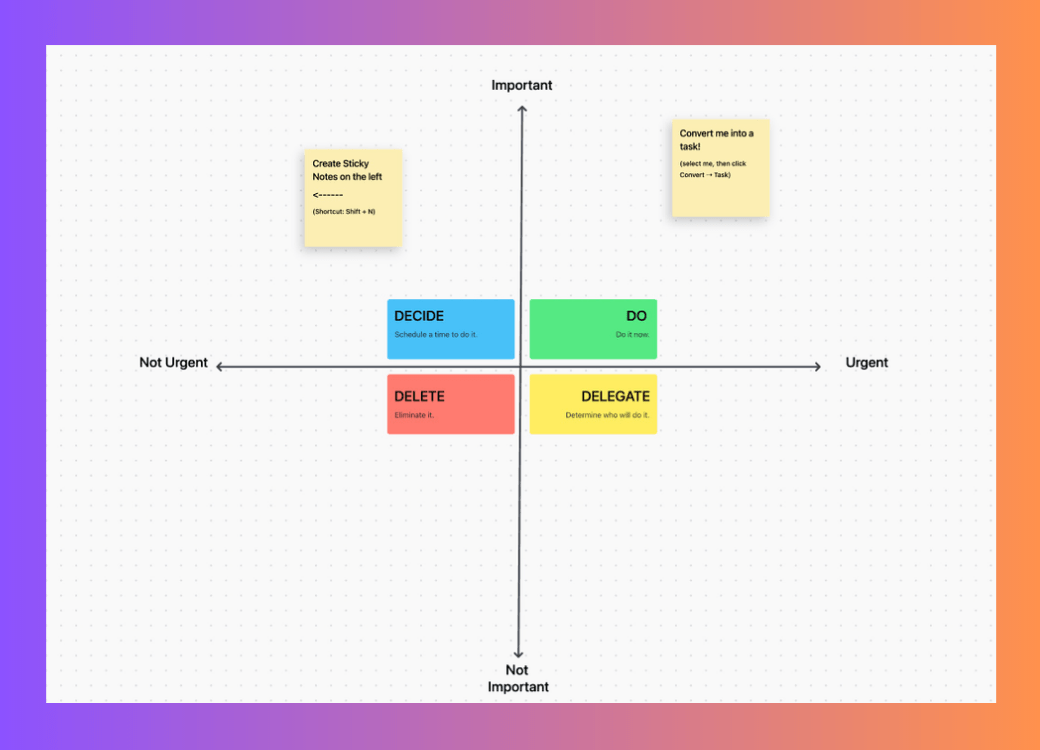
قم بفرز قوائم المهام الضخمة بسهولة باستخدام قالب مصفوفة أيزنهاور من ClickUp
بناء القالب الخاص بك مصفوفة أيزنهاور يمكن أن تستغرق وقتًا طويلاً، ولكن لحسن الحظ أننا أنشأنا بالفعل قالب مصفوفة كليك أب أيزنهاور للمساعدة في تسريع العملية. أضف إلى قائمة مهامك، وأنت في طريقك إلى إدارة الوقت والمهام بشكل أفضل.
5. جرب إنجاز المهام (GTD)
عقولنا مشغولة باستمرار، مما قد يجعل من الصعب فهم ما يجب العمل عليه بعد ذلك. كتاب ديفيد ألين الشهير إنجاز الأمور تساعدك طريقة (GTD) على معالجة أهدافك ومهامك، حتى تتمكن من اكتشاف طريقة قابلة للتنفيذ للمضي قدمًا.
تتم عملية GTD في خمس خطوات:
- التقاط الأفكار والمهام
- توضيح ومعالجة ما إذا كانت قابلة للتنفيذ أم لا
- تنظيمها إلى مهام قابلة للتنفيذ وأخرى غير قابلة للتنفيذ، ثم تجميعها حسب المهام
- التفكير للتأكد من أن قائمتك لا تزال ذات صلة بالموضوع
- انخرط في قائمة مهامك وأنجز مهامك
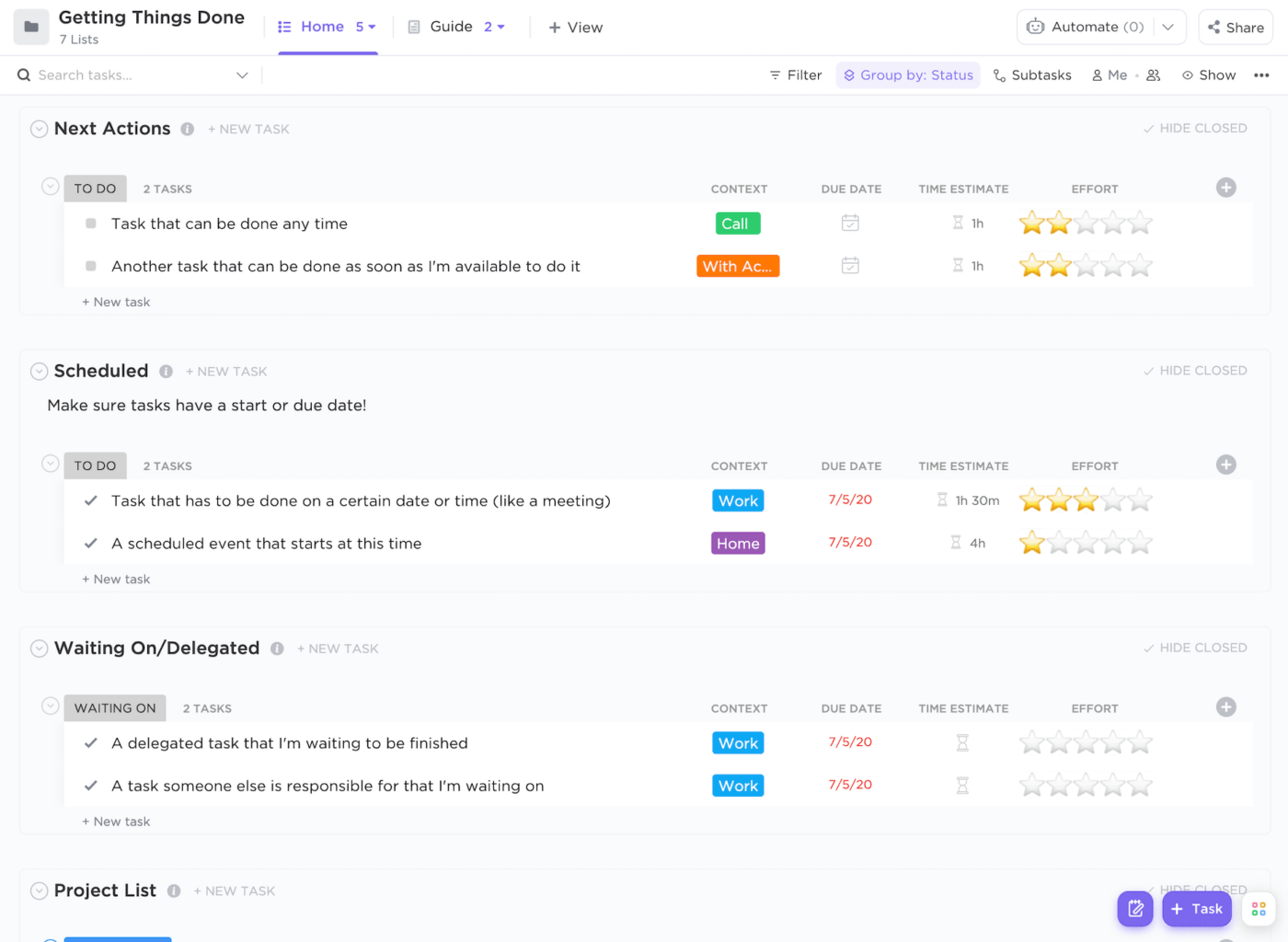
يساعدك قالب إنجاز المهام (GTD)، المستند إلى نظام GTD لديفيد ألين، على تنظيم المهام والمشاريع من خلال تسجيلها وتقسيمها إلى عناصر عمل قابلة للتنفيذ
هذا نظام إدارة الوقت الذي يتطلب الكثير من العمليات التي تتطلب الصيانة، ولكنه قد يكون وسيلة قيمة لمساعدتك في تحديد الأولويات والمضي قدماً إذا كنت تعاني من هذه المشكلة.
استخدم انقر فوق المفكرة لمساعدتك على العمل من خلال عملية GTD. عند الانتهاء من ذلك، يمكنك بسهولة تحويل ملاحظاتك إلى مهام، وإضافتها إلى قائمة مهامك، وترتيب أولوياتها وفقًا لذلك. ✅
أو استخدم برنامج إنجاز المهام مع الحقول المخصصة المُنشأة مسبقًا لتصنيف عناصر العمل في سياقات مختلفة. حدِّد أولويات المهام بناءً على السياق وتاريخ الاستحقاق والجهد المطلوب وغير ذلك، مع تبسيط العملية باستخدام مستندات تعاونية يمكن الوصول إليها من قِبل الفريق.
المكافأة: تحقق من قائمتنا الكاملة لـ
/ href/ https://clickup.com/blog/gtd-templates//** قوالب قوالب TD //%href/**_
6. استخدم لوحة كانبان
لكي تكون فعالاً حقاً في إدارة المشاريع، تحتاج إلى معرفة المرحلة التي وصلت إليها مهامك بالضبط. وهنا يأتي دور نهج كانبان. باستخدام لوحة كانبان، يمكنك أن تتخيل أين وصلت مهامك في المرحلة مشاريعك ومهامك في العملية - حتى تتمكن من التعامل مع العقبات والتحديات بشكل استباقي. 🤩
تحتوي لوحة كانبان على أعمدة مختلفة تتعلق بحالة المشروع، مثل:
- لم يبدأ
- بدأت
- قيد التنفيذ
- قيد المراجعة
- جاهز

قم بسحب أي مهمة وإفلاتها في العمود التالي لتحديث حالتها تلقائيًا باستخدام طريقة عرض لوحة تشبه لوحة كانبان في ClickUp
في اللوحة الخاصة بك، يمكنك تعيين المهام لكل قسم أو سحب وإسقاط مهمة معينة إلى العمود الصحيح. يمكنك بعد ذلك أن ترى في لمحة سريعة أين أنت، وتحديد العوائق التي تعترض طريقك، والتحقق من أعضاء الفريق للتأكد من أنهم على المسار الصحيح.
أضف لوحة كانبان إلى سير عملك إذا كنت تريد رؤية أفضل لما يحدث في مشاريعك. استخدم واحدة من قوالب لوحة كانبان وتوصيل بياناتك، أو تخصيصها بشكل أكبر لإنشاء طريقة مخصصة تمامًا لإدارة جميع المهام والوقت.
7. تتبع وقتك
قد تظن أنك منتج للغاية أو تعلم أنك متأخر في العمل، ولكن الطريقة الوحيدة لقياس ذلك حقًا هي تتبع وقتك. يمنحك تتبع وقتك بيانات قيمة يمكنك استخدامها لتغيير طريقة عملك للأفضل.
فأنت تعمل على مدار اليوم على مهام مهمة، لكن المهام الصغيرة والمشتتات تتسلل إليك أيضًا. يساعدك تتبع وقتك على معرفة الوقت الذي تقضيه في التحقق من وسائل التواصل الاجتماعي، والرد على رسائل البريد الإلكتروني، ومساعدة زملائك في العمل، وجميع المهام الأخرى التي قد لا تحسبها. 📚
![]()
تتبع الوقت وتعيين التقديرات وإضافة الملاحظات وعرض تقارير عن وقتك من أي مكان باستخدام المؤقت العام في ClickUp
إذا كنت بالفعل من مستخدمي ClickUp، فلن تحتاج إلى أداة مخصصة لتتبع الوقت لمساعدتك في معرفة مقدار الوقت الذي تقضيه في كل مهمة.
لدينا المدمج في ميزة تتبُّع وقت المشروع في ClickUp تمنحك طريقة سريعة وبسيطة لتتبع وقتك، وإنشاء قوالب تتبع الوقت ، مجموعة تقديرات الوقت وعرض تقارير حول كيفية قضاء وقتك. يمكنك أيضًا استخدام قوالب الجداول الزمنية لتقديم طريقة جديدة لعرض الوقت المستغرق في فريقك.
8. تطبيق مبدأ باريتو
هناك قاعدة شائعة تقول أن 80% من نتائجك تأتي من 20% من جهودك. ويُعرف ذلك باسم تحليل باريتو أو مبدأ باريتو، وهي طريقة أخرى للتعامل مع عادات إدارة وقتك.
إن فهمك أن أقلية صغيرة فقط من عملك هي التي تدفعك إلى الأمام يشجعك على تحديد تلك المهام التي تغير قواعد اللعبة. وعندما تعثر عليها، ستعرف أن عليك التركيز على تلك المهام لتحقيق أفضل النتائج. تساعدك نصائح إدارة الوقت مثل مبدأ باريتو في الحفاظ على تركيزك وتجنب التشتت في العمل العميق. 👀

تتيح ميزة "المهام في قوائم متعددة" (TIML) في ClickUp للمطورين ربط المهام مع فرق أخرى عبر المؤسسة
ClickUp هو مكان مفيد ليس فقط لتسجيل قائمة المهام الخاصة بك ولكن لتحديد أولويات مهامك المهمة أيضًا. لدينا ميزة المهام مليئة بالخيارات القابلة للتخصيص لمساعدتك على تصور ما هو ذي صلة، ووضع علامة على مهامك الأكثر قيمة، والتحقق منها عند الانتهاء.
9. الحد من تبديل السياق
بينما يدعي بعض الأشخاص أنهم بارعون في تعدد المهام، إلا أنك عادةً ما تحتاج إلى فترات من التركيز العميق لتحقيق أهدافك. إن التبديل بين السياقات، حيث تقفز من مهمة إلى أخرى، يؤدي إلى لحظات من المماطلة وانخفاض الإنتاجية.
بالنسبة لبعض الأشخاص يحدث هذا في كثير من الأحيان، لذلك الاختراقات الإنتاجية التي تساعدك على الحد من التبديل بين السياقات تصبح لا تقدر بثمن. ابحث عن طرق للبقاء في المنطقة والحد من التبديل بين السياقات.
قم بتضمين مستندات ClickUp المباشرة مباشرةً في اللوحات البيضاء للوصول إلى مستندات المشروع المهمة والبحث والسياق دون مغادرة اللوحة
ضع هاتفك في مكان آخر، وقم بإيقاف تشغيل الإشعارات، وأغلق النوافذ والتطبيقات، واجعل نفسك غير متاح للآخرين. اخلق نوع البيئة التي تعزز العمل العميق. ✨
هناك العديد من الطرق التي يمكن أن يساعدك بها ClickUp في الحفاظ على تركيزك والحد من التبديل بين السياقات. استعد تركيزك من خلال إدارة إشعاراتك وفتح المهام في وضع ملء الشاشة لتجنب تشتيت الانتباه، والعمل دون اتصال بالإنترنت حتى تتمكن من البقاء في وضع التركيز لفترة أطول.
10. تعلم أن تقول لا
هذه ليست مجرد تقنية لإدارة الوقت في العمل، ولكنها تنطبق في جميع مراحل حياتك. تعلّم أن تقول لا، حتى لا ينتهي بك الأمر مرهقًا وغير قادر على إكمال أي شيء على الإطلاق.
هناك دائمًا المزيد من العمل الذي يجب القيام به، وهناك دائمًا زميل في العمل يحتاج إلى مساعدتك لمدة خمس دقائق فقط. هناك دائمًا المزيد من الاجتماعات والمزيد من المشاريع والمزيد من الفرص المتعلقة بالعمل. تعلّم أن تقول لا، وأن تحمي وقتك وتمنح طاقتك للمهام الأكثر أهمية. 🙌
ليس من السهل دائمًا أن تقول لا - خاصةً لمديرك أو لشخص تريد مساعدته ولكنك لا تستطيع توفير الوقت له. حاول أن تقول "أود أن أساعد، ولكن لا يمكنني ذلك حتى تاريخ كذا" أو "بالتأكيد، يمكنني أن أحضر ذلك، ولكن ما الذي يجب أن أتركه بدلاً من ذلك؟
تعزز هذه الردود من قيمة وقتك، وتمنح مقدم المهمة فرصة لإعادة ترتيب أولويات قائمة مهامه الخاصة.
11. جرب صندوق الوارد صفر
يستخدم بعض الأشخاص صندوق الوارد الخاص بهم كقائمة مهام. وبينما ينجح ذلك في بعض الأحيان، قد يكون صندوق الوارد بالنسبة لأشخاص آخرين مصدرًا للرهبة. الطلبات المتنافسة على المعلومات، والمشتتات التي لا تنتهي، والمحادثات التي لا تحتاج إلى انتباهك.
للمساعدة في مكافحة المماطلة، حاول تحقيق ما يلي صندوق الوارد صفر .
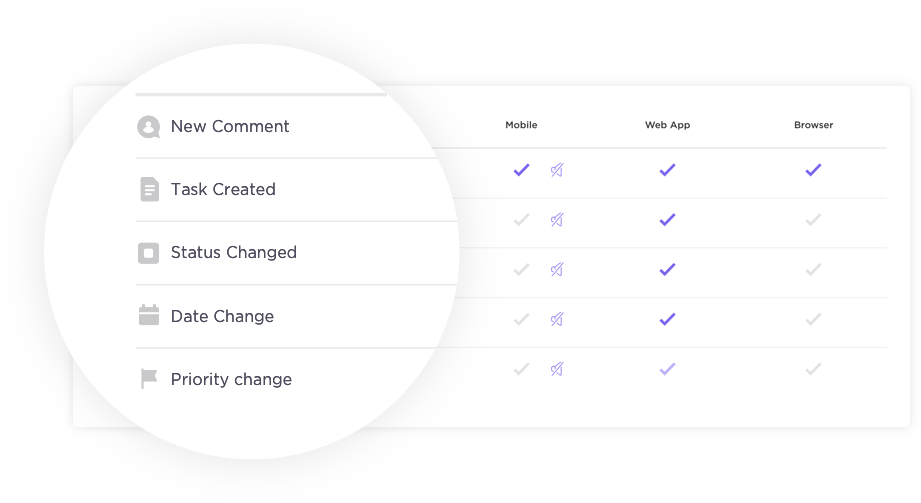
احصل على إشعارات مفصلة في ClickUp لتلقي التحديثات أو الإشارات الأكثر أهمية بالنسبة لك فقط
إن "صندوق الوارد صفر" هو المكان الذي تقوم فيه بإخلاء صندوق الوارد الخاص بك بحلول نهاية اليوم وتهدف إلى إبقائه على هذا النحو. ابدأ يومك بمراجعة صندوق الوارد الخاص بك ثم قم بتصنيف كل عنصر.
إذا كانت مهمة صغيرة، فقم بها على الفور، ثم احذف البريد الإلكتروني أو احفظه في ملف. أما بالنسبة للمهام الأخرى التي تحتاج إلى رد ولكن ليس على الفور، فقم بحفظها في مجلد لتتعامل معها لاحقًا. بهذه الطريقة، سيبدو صندوق الوارد الخاص بك منظمًا ومقصودًا - وليس مكانًا تقاتل فيه دائمًا للحاق بالركب. 🌻
12. استخدم تقنية بومودورو
لا تزال تقنية بومودورو، التي ابتكرها فرانشيسكو سيريلو، واحدة من أكثر الطرق شيوعًا لإنجاز المهام والحفاظ على الإنتاجية. تتضمن أداة إدارة الوقت هذه العمل في مجموعات مركزة من الوقت ثم أخذ فترات راحة قبل العودة إلى ما كنت تعمل عليه.
يعزز أسلوب إدارة الوقت هذا ضرورة وجود فترات راحة ووقت للراحة بين المهام ويمكن أن يساعدك على تجنب المماطلة.
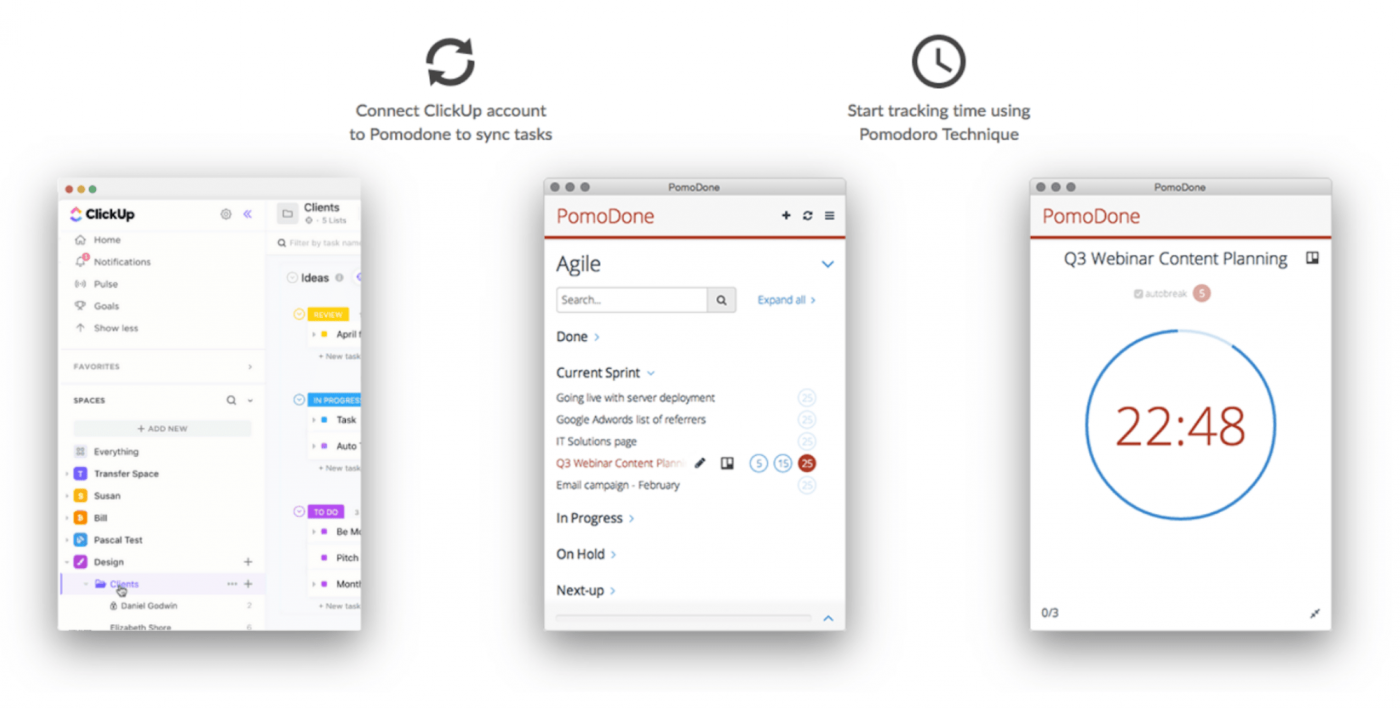
تتبع توقيت تقنية بومودورو الخاصة بك تلقائيًا باستخدام تطبيق بومودون + تكامل ClickUp
باستخدام تقنية بومودورو، تعمل لمدة 25 دقيقة ثم تأخذ استراحة لمدة 3-5 دقائق. بعد القيام بذلك أربع مرات، تأخذ استراحة أطول من 15-30 دقيقة للراحة والاسترخاء والشعور بالانتعاش. يمكنك بعد ذلك اختيار الاستمرار في أسلوب إدارة الوقت هذا على مدار اليوم أو التحول إلى العمل على شيء مختلف.
إذا اتبعت الأسلوب المعتاد تطبيق بومودورو لا يناسبك، جرّب استخدام التوقيت الزمني بدلاً من ذلك. فهو يتبع مبدأ مماثل للعمل في مجموعات من الوقت، ولكن لك الحرية في تعيين الحدود الزمنية ومدة فترات الراحة.
بفضل التكامل مع تطبيق بومودون ، أصبح استخدام تقنية بومودورو أثناء العمل في ClickUp أسهل. استخدم التكامل لتتبع وقتك عبر المهام، وأخذ فترات راحة طبيعية، والاطلاع على تقارير حول كيفية عملك. 👀
13. استخدم طريقة التخطيط السريع
بالنسبة للأشخاص الذين يرغبون في الخروج من منطقة الراحة الخاصة بهم والتفكير في نهج أكثر شمولية لإدارة الوقت، فإن طريقة توني روبنز طريقة التخطيط السريع (RPM) تستحق الدراسة.
يشجعك هذا النهج على استكشاف رغباتك وهدفك ومتطلباتك، حتى تتمكن من اتخاذ الإجراءات اللازمة لتحقيق ذلك. يرمز RPM إلى:
- موجه نحو النتائج
- مدفوعة بالغرض
- خطة عمل شاملة
إنها تقنية تحثك على النظر إلى الطريقة التي تتناسب بها المهام مع خطة العمل (أو الحياة) . بمرور الوقت، يمكن أن يساعدك ذلك على تحديد أولويات المهام والمشاريع التي ترسلك نحو وجهتك وترفض أو تفوض المهام التي لا تفعل ذلك. 👋
14. جرب تجميع المهام
إذا كنت تعمل مع الكثير من المهام الصغيرة، فإن تجميع المهام يمكن أن يحدث ثورة في إنتاجيتك ويساعدك على إنجاز المزيد من المهام. يتضمن تجميع المهام تجميع المهام المتشابهة معًا، ثم العمل عليها جميعًا مرة واحدة. ⚒️

استخدم ClickUp Whiteboards لتعيين المهام، ووضع علامات على المعينين، وأي شيء مطلوب لبدء تعاونك التالي
تجميع المهام هو ترياق مفيد إذا كنت تميل إلى التبديل بين السياقات. فبدلاً من التبديل بين المهام اليومية لمجرد نزوة، يمكنك تعيين مهام محددة لفترة زمنية محددة والدخول في المنطقة.
لا يعمل هذا الأمر مع المهام فقط - جرب تجميع المكالمات الهاتفية أو جدولة جميع اجتماعاتك في يوم واحد من الأسبوع. هذا الأمر مثالي لفرق المبيعات التي تحاول إجراء عدد من المكالمات الهاتفية أو رسائل البريد الإلكتروني في نفس الوقت.
15. استخدام الذكاء الاصطناعي (AI)
هناك المئات من تطبيقات الذكاء الاصطناعي التي تظهر كل يوم. في حين أن هذا الأمر قد يكون مربكًا، إلا أنه يمثل أيضًا فرصة مثيرة للاهتمام - ما الذي يمكنك أتمتته أو تسريعه أو تحسينه بمساعدة الذكاء الاصطناعي؟
هناك تطبيقات مدعومة بالذكاء الاصطناعي تساعدك على إنشاء الصور، وكتابة المحتوى، وتلخيص مكالمات الفيديو، وغير ذلك الكثير. على الرغم من عدم وجود ذكاء اصطناعي مثالي حتى الآن، إلا أن هذه التطبيقات تقطع شوطاً طويلاً في المساعدة على إزالة المهام من قائمة مهامك. ومع شطب هذه المهام الصغيرة من قائمتك، يصبح بإمكانك التركيز على المجالات التي تحقق أكبر قدر من التأثير.

تجعل وظائف الذكاء الاصطناعي في ClickUp من السهل على فرق التسويق إنتاج مستندات مثل دراسة الحالة أدوات وميزات مدعومة بالذكاء الاصطناعي مثل ClickUp AI يساعدك على الارتقاء بإنتاجيتك إلى مستويات جديدة. قم بإنشاء عناصر العمل، وتلخيص ملاحظات الاجتماعات، وتحرير النسخ، وتنسيق المحتوى، والعصف الذهني للأفكار بمساعدة الذكاء الاصطناعي.
بدلاً من قضاء ساعات في التفكير في سطر الموضوع المثالي للبريد الإلكتروني، اطلب من الذكاء الاصطناعي لدينا أن يعمل بسحره ويقدم لك بعض الخيارات. ما زلنا في البداية فقط، وهناك الكثير من الإمكانات أمام الفرق التي تستثمر في قوة الذكاء الاصطناعي. 🤩
استعد للنجاح مع هذه النصائح لإدارة الوقت
إن تغيير طريقة تفكيرك في الوقت واستخدامه لا يحدث في لحظة. خصص بعض الوقت للتفكير في تقنيات إدارة الوقت هذه، واكتشف أيها من المحتمل أن ينجح معك وجربها.
لن تهبط على النهج الصحيح على الفور، ولكنك ستتعلم دائمًا شيئًا جديدًا عن نفسك.
إذا كنت مستعدًا لتحويل عاداتك الجديدة في إدارة الوقت إلى اتجاه نحو أن تكون أكثر إنتاجية, جرب ClickUp مجانًا .
ClickUp ليس مجرد مكان لتتبع وقتك أو تحديد أولوية أهدافك - إنه مركز الإنتاجية النهائي. قم بإدارة عملك، وتعاون مع أعضاء الفريق، وتبنَّ نهجاً أكثر تنظيماً في العمل.

